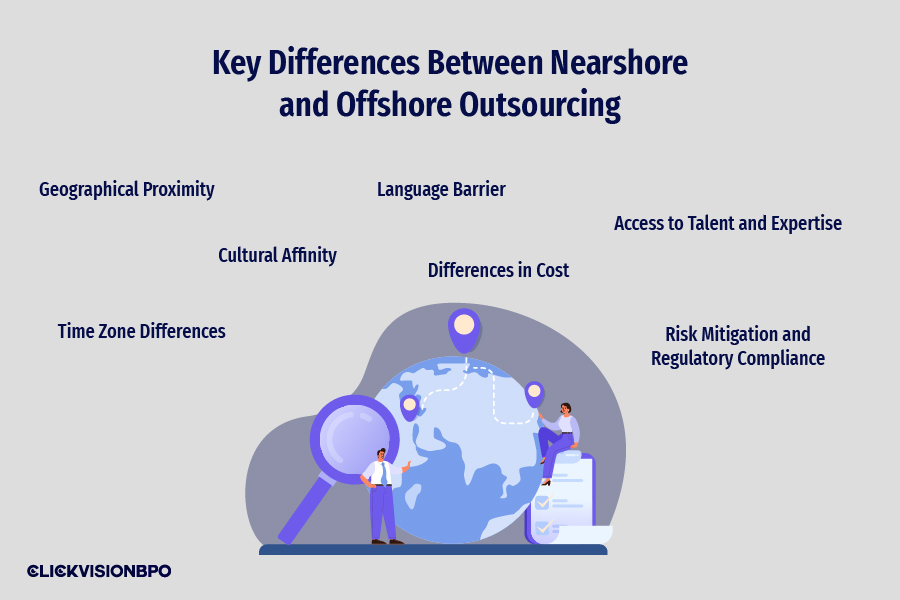Outsourcing has become an integral business strategy for businesses seeking to optimize their operations. Within the realm of such practice, two distinct models have emerged – nearshore vs offshore outsourcing. So, what is the difference?
Understanding the distinction between these two approaches is crucial for leveraging external sources effectively. Hence, in this post, we will explore their advantages and challenges and discuss their suitability for various business needs.
Nearshore Outsourcing vs Offshore Outsourcing
Overview
In the modern business landscape, outsourcing has become a strategic cornerstone for businesses seeking to streamline their processes. Many outsourcing options are available, the most prevalent ones being nearshore and offshore outsourcing.
While both involve delegating tasks and projects to external entities, both models differ significantly in various aspects. Nearshore outsourcing involves a company designating specific tasks or projects to third-party outsourcing providers located in nearby countries and regions.
They are typically within the same or neighboring time zones. Nearshore outsourcing is a popular model among companies as it alleviates the need to train an in-house team or invest in resources. In comparison, offshore outsourcing entails delegating business tasks or projects to companies located in distant countries.
These vendors are located in distant countries, situated in distant continents and time zones. Many enterprises opt for this model due to lower labor costs.

Source: freepik.com / Photo Contributor: rawpixel.com
Understanding Nearshore vs Offshore Outsourcing
Some companies opt for nearshore outsourcing destinations due to proximity, similar time zones, and shared cultural and linguistic traits. These factors can facilitate smoother workflow integration and project management.
On the other hand, enterprises may opt for offshore outsourcing due to lower labor and operational costs. This model gives access to a broader talent pool and capitalizes on specialized expertise not readily available domestically.
In today’s globalized business landscape, outsourcing is a strategic imperative for companies opting to enhance efficiency. This approach can enable your company to optimize costs and focus on core competencies. At CLICKVISION BPO, we understand the importance of making the right business decisions.
The choice between nearshore and offshore outsourcing is crucial for meeting client needs and ensuring operational excellence. Hence, in continuation, we will explore factors to consider to help you make the best option when considering these models.
Key Differences Between Nearshore and Offshore Outsourcing
The differences between the two outsourcing models include geographical proximity, time zone differences, cultural affinity, language barrier, differences in cost, and access to talent and expertise.
Geographical Proximity
Nearshore outsourcing offers close proximity and enables more accessible travel between the client and the service provider’s location. For instance, a company in the US outsourcing tasks in Canada or Mexico.
Such short distance facilitates in-person meetings, enhances collaboration, and fosters a strong sense of partnership. If needed, you can visit the outsourcing team and communicate face-to-face. This is especially beneficial if you need to make sudden changes in the project, adjust requirements, and make changes or updates.
Similar time zones enable clear communication and a quicker response time to client issues and inquiries. As a result, the proximity can contribute to effective project management and effortless problem-solving.
Offshore outsourcing involves contracting services to a neighboring or nearby country. Common examples of such outsourcing include countries like India, the Philippines, or Eastern European nations from the United States or Western Europe.

Source: freepik.com / Photo Contributor: rawpixel.com
Time Zone Differences
In nearshore outsourcing, the time zone differences are minimal or non-existent. Hence, such an approach ensures overlapping working hours between the client and the outsourcing team. Such synchronicity commonly promotes seamless communication and minimizes delays in project timelines.
Conversely, offshore outsourcing companies might face significant time zone disparities. Such an outsourcing model may lead to communication challenges and delayed responses, causing potential disruptions in workflow.
Different time zones may also impact the overall project timeline and efficiency. Yet, it is essential to mention that many outsourcing companies are flexible and able to work in a suitable time frame to deliver projects on time.
Cultural Affinity
Cultural alignment is another significant differentiator between the two outsourcing models. Nearshore outsourcing offers a greater cultural affinity to its counterpart. It often involves collaborating with partners from countries and regions with shared cultural backgrounds.
The client and the outsource providers often share language similarities and business practices. Such compatibility fosters better understanding, straightforward communication, and smooth collaboration. It also encourages enhanced work ethics between the client and the outsourcing team.
Hence, nearshore outsourcing reduces the likelihood of misunderstandings, misinterpretations, and potential conflicts. Ultimately, cultural affinity can strengthen the working relationship between both parties and improve overall project outcomes.
These nuances can impact how teams interact and make decisions, impacting the project’s speed and quality. In comparison, offshore outsourcing may present cultural barriers, given the significant geographical distances. With this in mind, working with people from different cultural backgrounds can be slightly more challenging.
Language Barrier
Generally, nearshore outsourcing involves working with service providers who share a common language or have high proficiency in the client’s native language. Such linguistic compatibility fosters clear communication between the parties.
It reduces the risks of miscommunication and creates an environment for exchanging ideas and receiving requirements and feedback. Compared to this model, companies utilizing offshore outsourcing may encounter language barriers.
Such a model may require additional efforts to overcome communication gaps. They may include translation services, language training, or hiring bilingual staff. Overcoming such barriers is essential for effective collaboration.
At CLICKVISION BPO, we recognize clients’ need for effective communication and close collaboration. Hence, we ensure prompt communication and swift resolution of queries, fostering a sense of partnership with our clients.
Differences in Cost
Many companies opt for nearshore or offshore practices as a cost-effective alternative to onshore or in-house operation. Generally, offshore outsourcing typically offers the most cost savings due to lower labor costs and overhead expenses in neighboring countries.
Hence, offshore outsourcing is an attractive solution for businesses seeking lower labor expenses and service charges. In comparison, nearshore services may come with a slightly higher price tag than offshore options due to higher costs for labor and overhead expenses in neighboring countries.
Our team of professionals at CLICKVISION BPO prioritizes quality, accessibility, and streamlined communication. We ensure your investment translates into quality outsourcing service delivery and enhanced client satisfaction.
Access to Talent and Expertise
Typically, what drives many companies to outsource is the need for a workforce with the required training and skills in their region. This approach can give you access to thousands of highly qualified professionals without needing internal recruitment.
Nearshore outsourcing gives companies access to a large variety of service providers. However, the offshore approach opens the door for a global talent pool. Thanks to such access, offshore outsourcing can offer more flexibility and scalability.
With this practice, you can hire diverse talents who possess specialized skills. By hiring outsourcing providers with the necessary knowledge and training, companies avoid the expenses of training and investing to do so in-house.
Risk Mitigation and Regulatory Compliance
Nearshore outsourcing serves as a middle ground between outsourcing models regarding regulatory compliance, data protection laws, and intellectual property rights. Proximity to the client’s home country often means greater familiarity with legal frameworks and regulatory requirements.
On the other hand, offshore outsourcing requires careful attention to regulatory compliance, data security protocols, and intellectual property protection. This is especially true when partnering with vendors in countries with different legal systems and standards. Robust contracts, non-disclosure agreements, and thorough due diligence are our recommendations to mitigate risks effectively.

Conclusion
Outsourcing models come with a set of advantages and challenges. The decision between nearshore vs offshore outsourcing hinges on several different factors. Nearshore offers benefits like linguistic compatibility, cultural affinity, and geographical proximity.
In comparison, offshore outsourcing gives access to a broad talent pool, specialized expertise, and cost savings. Therefore, choosing between these approaches requires careful evaluation of your company’s specific requirements, priorities, and preferences. By making a suitable choice, you can maximize efficiency, drive innovation, and exceed client expectations in the ever-evolving outsourcing landscape.

With a strong background in the marketing industry and healthcare leadership roles, Filip is responsible for CLICKVISIONBPO’s sales strategies and onboarding new clients. With a passion for sharing insights gained from his experience, he also shares valuable knowledge through industry related articles.
